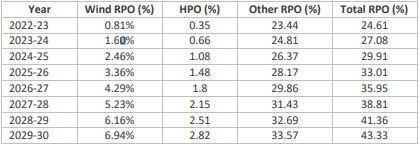HSA Advocates are most popular:
- within Tax, Intellectual Property and International Law topic(s)
- with Finance and Tax Executives
- with readers working within the Law Firm industries
Electricity (Late Payment Surcharge and Related Matters) Rules, 2022
- The Ministry of Power, Government of India (MOP) on June 3, 2022 notified the Electricity (Late Payment Surcharge and Related Matters) Rules, 2022 (LPSC Rules), to bolster the provisions to recover the outstanding dues of the Distribution Companies (DISCOM).
- LPSC Rules will be applicable to outstanding dues of Generating Companies (GENCOS), Inter-State Transmission Licensees and Electricity Trading Licensees.
Salient aspects of LPSC Rules
- Applicability of LPSC: The LPSC Rules state that DISCOMs will be obligated to pay the late payment charges (LPS) on their outstanding amount after the Due Date at the Base Rate, applicable for the first month of default. Upon successive months of default, the rates will increase by 0.5% for every month of delay. However, capping is done which is not more than 3% higher than Base Rate and further, LPS shall not be higher than the rate of LPS specified in the agreement between the Parties.
- Payment adjustments: All payments made by the DISCOMs will be first adjusted towards LPS and thereafter, towards monthly charges, starting from the longest overdue bills.
- Intimation of Payment Schedule: By July 2, 2022, DISCOMs are required to communicate in writing to the Generating Companies (GENCO) Transmission Company (TRANSCO) or trading licensee (Trader), the outstanding dues and the number of EMIs in which the outstanding dues would be paid by them.
- Operationalization of Payment Security Mechanism: A DISCOM or other user of transmission system has to maintain unconditional, irrevocable, and adequate payment security mechanism (PSM) as required under this LPS Rules. Supply of power will only be made if adequate PSM is made available, otherwise the GENCOs would not be able to collect LPS from DISCOMS.
- Mandatory scheduling obligations for requisitioning of power: The DISCOM will have to intimate the respective GENCO its schedule for requisitioning power for each day at least two hours before the end of the time for placing bids in the day ahead market (DAM) for that day.
- Regulation of access of power to defaulting entities: In case of non-payment of dues, by DISCOM, even after 2.5 months after presentation of bill as per this LPS Rules, the short-term power supply to the defaulting entity shall be regulated entirely as per the process set in LPS Rules. Subsequent default after regulation of short-term supply or continuing default for 3.5 months would eventually lead to regulation of long term access (LTA) and medium term access (MTA) by 10%. Increase of 10% will be for subsequent defaults.
- Supply obligation: GENCOs are obligated to offer the contracted power to DISCOMs according to the mutually agreed terms. Prior consent of DISCOM is required by GENCOs to sell power to other parties under the LPS Rules.
- EMI structure: Total outstanding dues
including LPS up to the date of notification of LPS Rules shall be
re-scheduled and the due date of the payment shall also be
re-determined in the following monthly instalments.
Outstanding dues (in INR Crore) Maximum EMIs (in months) Up to 500 12 501 - 1,000 20 1,001 - 2,000 28 2,001 - 4,000 34 4,001 - 10,000 40 >10,000 48 - Operationalization of PSMs: GENCOs, TRANSCOs, Traders are obligated to regulate supply of power depending upon maintenance or non-maintenance of requisite payment security.
- Power supply arrangements: Upon default in payment of outstanding dues, supply from GENCOs would be reduced to 75% and the remaining 25% would be sold through Power Exchange. Further, continuance of such default will give authority to the GENCO to sell full power through Power Exchange.
- Pre-requisitioning of power by DISCOMs: GENCOs are given the liberty to sell power at Power Exchange platforms if there is no intimation of schedule as per LPSC Rules. DISCOMs would be obligated to pay compensation for non-requisitioned power from must-run project, at applicable PPA tariff rate.
- GENCO's failure to supply contracted power: If the GENCO fails to offer the contracted power as agreed with DISCOM and sells such power to any third party without the DISCOM's consent, the said GENCO, on a complaint to this effect by the DISCOM to the load dispatch centre concerned, shall be debarred from participating in Power Exchanges and on the Discovery of Efficient Electricity Pricing portal and scheduling of any new short-term contracts from that GENCO for a period of three months from the date on which the default has been taken cognizance by the concerned load dispatch centre.
- Compliance of EMI Schedule: The LPS will be applicable on entire outstanding dues as on the date of notification of LPSC Rules, upon delay in payments in terms of the prescribed monthly instalment schedules. Non-compliance of payment obligations will result in regulation of access to the defaulting entities in terms of the procedure prescribed in the LPSC Rules.
Ministry of Power's Order on Renewable Purchase Obligation and Energy Storage Obligation Trajectory till FY-2029-30
- The MOP vide its Order dated July 22, 2022 (Order), notified the Renewable Purchase Obligation (RPO) and Energy Storage Obligation (ESO) Trajectory till FY 2029-30, whereby a long-term growth trajectory has been set out.
- The Order has been issued in pursuance of Para. 6.4 (1) of the National Tariff Policy, 2016, which stipulates that the MOP in consultation with the Ministry of New and Renewable Energy (MNRE) will prescribe such long-term trajectory. Notably, the Government on March 8, 2019, recognized Large Hydro Projects (LHPs) including Pumped Storage Projects (PSPs), over 25 MW as part of Renewable Energy (RE). Energy from all LHPs commissioned after March 8, 2019 will be considered as part of RPO through a separate Hydro Power Purchase Obligation (HPO).
- The MOP in consultation with MNRE has previously notified the HPO trajectory until FY 2021-22. Through the present Order, the trajectory to be followed beyond the said period has been provided, details of which are discussed in this note.
- RPO trajectories:
- The RPO trajectory notified for the period after FY 2022 is set
out below:

- - FY 2022-23 onwards, the energy from all Hydro Power Projects (HPP) will be considered a part of RPO, under the category of (Other RPO). Notably, Wind RPO targets can be only met when the energy is produced from the Wind Power Projects (WPPs), HPO targets can be only met through energy produced from LHPs including PSPs and Other RPO targets can be met through energy produced from other sources apart from Wind and Hydro power.
- It can be seen from the table above that, for FY 2022-23, MOP has mandated that 24.61 % of the total energy procured by a Distribution Licensee (DISCOM) will have to be from RE sources. Such RPO includes 0.81 % Wind RPO, 0.35 % HPO and 23.44 % Other RPO.
- The target to be met by FY 2029-30 is that a DISCOM procures 43.33 % of its total consumption from RE sources (6.94 % Wind RPO, 2.82 % HPO and 33.57 % Other RPO).
- RPO is to be calculated in terms of energy which is percentage of total consumption of electricity. HPO obligations can be met through power procured from eligible LHPs commissioned on and after March 8, 2019, till March 31, 2030.
- State Electricity Regulatory Commission(s) have been granted the liberty to notify RPO trajectory including HPO and ESO for their respective States, over and above the RPO, HPO and ESO trajectory notified vide the present Order.
- The RPO trajectory notified for the period after FY 2022 is set
out below:
- HPO of DISCOM(s):
- The HPO of DISCOM(s) can be met out through free power provided to the state from LHPs including PSPs commissioned after March 8, 2022, according to the agreement prevailing at that time. However, the contribution towards Local Area Development Fund will be excluded from the same if it is consumed within the State or DISCOM(s) area of supply.
- In case of shortage of free power, the State is required to buy additional Hydro Power to meet its HPO. Alternatively, the State may have to buy Renewable Energy Certificates(s) (REC / RECs) corresponding to Hydro Power required to meet HPO.
- REC Mechanism:
- The Central Electricity Regulatory Commission (CERC) shall develop the REC Mechanism in order to facilitate HPO compliance, which will have a capping price of INR 5.50/Unit of electrical energy w.e.f. March 8, 2019, to March 31, 2021. The annual escalation will be 5% for HPO compliance purposes. HPO trajectory is to be trued-up annually on the basis of revised commissioning schedule of Hydro Projects.
- Hydro Power imported from outside India shall not be considered for meeting HPO.
- Shortfall in achievement of Other RPO in a particular financial year, can be met through excess energy consumed from WPPs commissioned after March 31, 2022 (beyond Wind RPO for that particular year) or through excess energy consumed from LHPs commissioned after March 8, 2019 (beyond the HPO), or partly from both sources.
- Further, the Order states that CERC may consider devising an appropriate mechanism which will be similar to REC mechanism to ensure HPO compliance.
- ESO:
- ESO has been fixed at 1% for FY 2023-24 and 4% for FY 2029-30. It has been specified that the ESO shall be calculated in energy terms as a percentage of total consumption of electricity and shall be fulfilled only when at least 85% of the total energy is stored in the Energy Storage System (ESS).
- ESO to the extent of energy stored from RE sources shall be considered as a part of fulfilment of total RPO.
- Management of RPO data:
- The Power System Operation Corporation has been designated to maintain the data related to compliance of RPO obligations.
Click here to continue reading...
The content of this article is intended to provide a general guide to the subject matter. Specialist advice should be sought about your specific circumstances.


